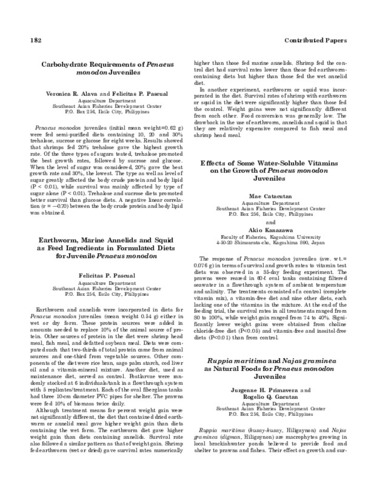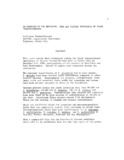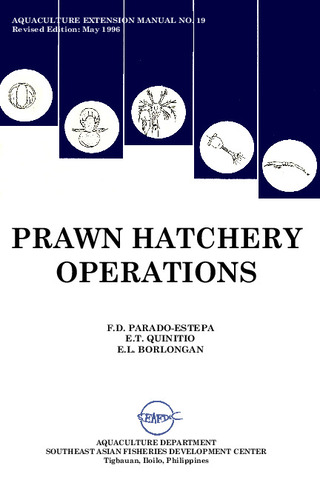Ruppia maritima and Najas graminea as natural foods for Penaeus monodon juveniles
- Global styles
- MLA
- Vancouver
- Elsevier - Harvard
- APA
- Help

วันที่
1985Page views
5,401ASFA keyword
AGROVOC keyword
Taxonomic term
เมตาดาต้า
แสดงระเบียนรายการเต็มShare
นามธรรม
Ruppia maritima (kusay-kusay, Hiligaynon) and Najas graminea (digman, Hiligaynon) are macrophytes growing in local brackishwater ponds believed to provide food and shelter to prawns and fishes. Their effect on growth and survival of Penaeus monodon juveniles (PL50; carapace length, 4.01 mm; body weight, 0.053 g) were studied in 80-ℓ glass aquaria. The treatments were: (a) a commercial pellet (40% protein); (b) live Ruppia; (c) decaying Ruppia; (d) live Najas; and (e) decaying Najas. The pellet was offered to satiety (approx. 100% of body weight) twice daily. Live Ruppia and Najas were transplanted in the aquaria using pond soil a week prior to the experiment. Decaying Ruppia and Najas were transferred from ponds. Salinity was maintained at 15 ppt and 50% of the water was changed regularly.
Highly significant differences (P < 0.01) in mean carapace length (CL) and mean body weight (BW) on the 10th, 20th and 30th days were observed among treatments. Increase in CL was fastest with decaying Najas and slowest in live Ruppia (14% vs. 17% after 30 days). Growth with decaying Ruppia was comparable to pellets on the 10th and 20th days but was faster after 30 days. Body weight on all sampling days was highest in decaying Najas and lowest in live Ruppia. Percentage increases were 122, 273 and 565% on the 10th, 20th and 30th days, respectively, with decaying Najas. Those given live Ruppia registered increases of 11, 67 and 94%, respectively. The rapid growth rate of animals on decaying Najas was compensated negatively by a low survival rate (31%), significantly lower than on live Najas (100%). Other survival percentages were: decaying Ruppia, 59% and pellet, 53%.
Description
Abstract only.
การอ้างอิง
Primavera, J. H., & Gacutan, R. Q. (1985). Ruppia maritima and Najas graminea as natural foods for Penaeus monodon juveniles (Abstract only). In Taki Y., Primavera J.H. and Llobrera J.A. (Eds.). Proceedings of the First International Conference on the Culture of Penaeid Prawns/Shrimps, 4-7 December 1984, Iloilo City, Philippines (pp. 182-183). Iloilo City, Philippines: Aquaculture Department, Southeast Asian Fisheries Development Center.
Type
Conference posterISBN
9718511008
Related items
Showing items related by title, author, creator and subject.
-
An overview of the nutrition, feed and feeding techniques of prawn penaeid/shrimps
Piedad-Pascual, Felicitas (Philippine Council for Aquatic and Marine Research and Development, 1989)This paper echoes what transpired during the first International Conference of Penaeid Prawns/Shrimps held in Iloilo City in December 4-7, 1984, particularly on the Nutrition nd Feed Development. Around 25 papers were ... -
Series: Aquaculture extension manual; No. 19
Prawn hatchery operations
Parado-Estepa, Fe D.; Quinitio, Emilia T. ; Borlongan, Emeterio L. (Aquaculture Department, Southeast Asian Fisheries Development Center, 1996-05)
The manual, an updated version of the 1984 SEAFDEC/AQD manual, presents the underlying principles and step-by-step instructions of prawn larval and post-larval rearing. The techniques described are not only applicable to ...
; Borlongan, Emeterio L. (Aquaculture Department, Southeast Asian Fisheries Development Center, 1996-05)
The manual, an updated version of the 1984 SEAFDEC/AQD manual, presents the underlying principles and step-by-step instructions of prawn larval and post-larval rearing. The techniques described are not only applicable to ... -
The lowdown on world shrimp culture - II
Yap, Wilfredo G. (INFOFISH, 2001)This paper introduces some new members of the international shrimp culture club and goes on to discuss some recent technological innovations in the industry, particularly the polyculture of tilapia (mainly Oreochromis ...






